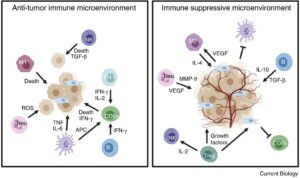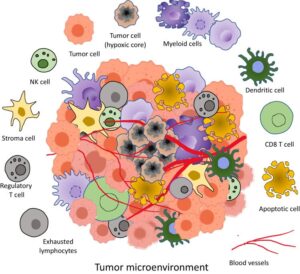Tumor Microenvironment: Tissue and Cells in Cancer
Tumor microenvironment has proven to be one of the factors that contribute significantly to the progression and dispersion of cancer. The tumor microenvironment is made up of cancer cells, surrounding tissues, immune cells, blood vessels and lastly the extracellular matrix. The regulation of cancer related genes in this system greatly affects behavior of tumors, making it a focal area of study in cancer.

The tumor microenvironment has been found to play some primary functions like providing support for the growth of tumors. Cancer cells have been noted to communicate with fibroblasts, immune system cells and endothelial cells of the microenvironment. These interactions can lead to tumor mass growth and survival. For example, cancer associated fibroblasts can produce growth factors and cytokines which may promote growth of tumor cell and at the same time prepare the ideal environment for cancer cells.

Doctors have come to a conclusion on the finding that tumor microenvironment can either lead to suppression or promotion of tumor growth. Immune cells also play a double role for example the cytotoxic T cells are known to target cancer cells while regulatory T cells suppress immune actions that may lead to the cells evading detection. The fact that cancer cells can avoid recognition by the immune system has been a major contribution to tumor development and spread.

It has been suggested that targeting the tumor microenvironment is a suitable approach to therapeutic strategy. To improve the treatment strategies that are currently available, scientists have always tried to interfere with the interactions between cancer cells and the extracellular microenvironment.
For instance, the identification of the immunosuppressive pathways within the tumor microenvironment can be targeted for therapeutic intervention so as to restore immune-response targeting of cancer cells.
PHOTO CREDIT: GOOGLE.COM
WRITTEN BY: AMEDICC.COM
